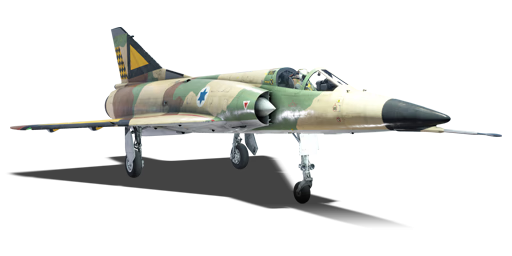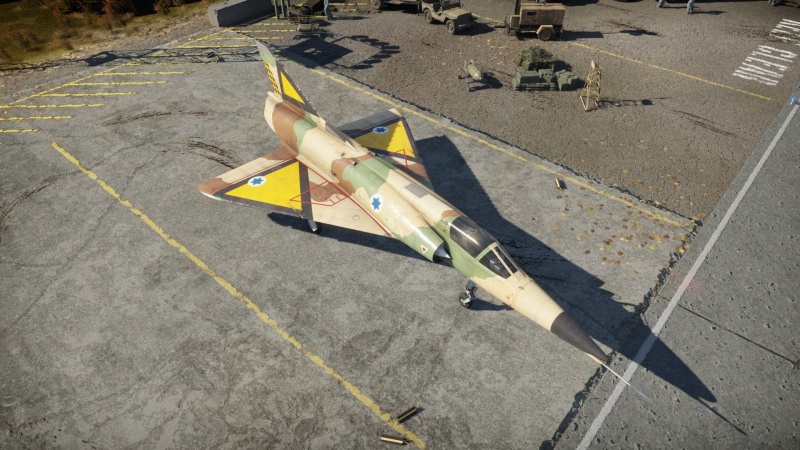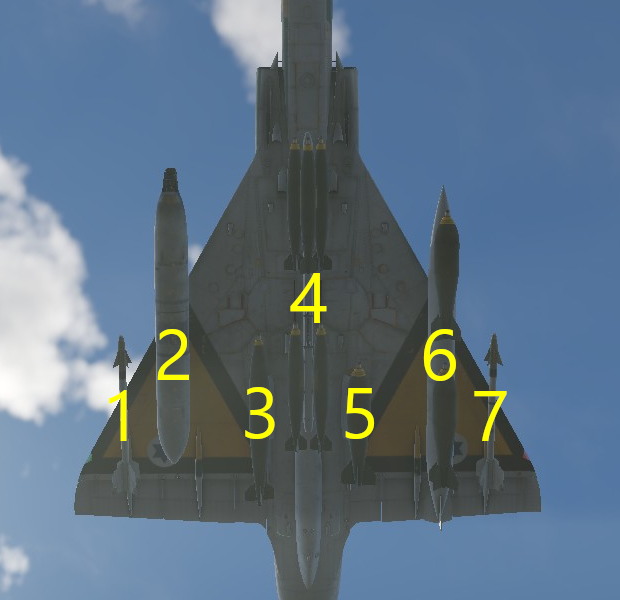Nesher
Contents
Description
The Nesher was meant to replace the Shahak in the IAF. It started as a hidden project, basically as a copy of the French Mirage 5 to avoid the embargo imposed over Israel during the Six-Day War. The aircraft started production in Israel in 1969, with a few changes to the design and electronics to suit Israeli needs more precisely. With the help of Dassault Aviation, different parts were smuggled into Israel. It featured Israeli-made avionics, compatibility with Shafrir 2 and AIM-9D AAMs, better range, and an ejection seat. The aircraft showed good performance during the 1973 Yom Kippur War, and served with Israel until 1978. Some of the single seat variants of the Nesher found a new owner in Argentina. Many were refurbished and then sold, serving in the Argentinian Air Force until 2015 under the name "Dagger".
Introduced in Update "Winged Lions", the Nesher flies like any other early Mirage. It is a fast plane with good AOA and agility as long as it has enough speed. Compared to the Shahak, the Nesher is capable of carrying enough ground ordnance to destroy a full base, however CAS duties are not recommended since the aircraft lacks any sort of ballistic computer. It has two hardpoints for air-to-air missiles, the AIM-9G being the most capable option at the end of the modifications tree. While the armament is nothing special for its BR, it compensates most of its flaws with good flight performance. It features 2 x DEFA 30 mm cannons that are very easy to aim, and when the missiles are used against enemies with no flares they are very hard to dodge. The most important thing about the Nesher is the speed, since it lacks flares, staying around Mach 1 is crucial to staying alive, even more when fighting enemies like the A-10, Su-25, or MiG-21SMT.
General info
Flight performance
The Nesher is a very fast and agile aircraft like many other delta wing fighters. However, it lags behind in terms of manoeuvrability compared to other jets of the Mirage family. But even with that, it has a good acceleration even when fully loaded when using the afterburner and is very fast at high altitudes, being capable of outmatching other fighters around its BR with ease.
| Characteristics | Max Speed (km/h at 12,000 m) |
Max altitude (metres) |
Turn time (seconds) |
Rate of climb (metres/second) |
Take-off run (metres) | |||
|---|---|---|---|---|---|---|---|---|
| AB | RB | AB | RB | AB | RB | |||
| Stock | 2,090 | 2,052 | 16000 | 29.5 | 30.6 | 109.9 | 99.9 | 750 |
| Upgraded | 2,227 | 2,160 | 26.2 | 28.0 | 172.4 | 140.0 | ||
Details
| Features | |||||
|---|---|---|---|---|---|
| Combat flaps | Take-off flaps | Landing flaps | Air brakes | Arrestor gear | Drogue chute |
| X | X | X | ✓ | X | ✓ |
| Limits | ||||||
|---|---|---|---|---|---|---|
| Wings (km/h) | Gear (km/h) | Flaps (km/h) | Max Static G | |||
| Combat | Take-off | Landing | + | - | ||
| 1,460 | 426 | N/A | N/A | N/A | ~10 | ~4 |
| Optimal velocities (km/h) | |||
|---|---|---|---|
| Ailerons | Rudder | Elevators | Radiator |
| < 920 | < 750 | < 650 | N/A |
Engine performance
| Engine | Aircraft mass | ||||||
|---|---|---|---|---|---|---|---|
| Engine name | Number | Basic mass | Wing loading (full fuel) | ||||
| SNECMA Atar 9C | 1 | 7,290 kg | 307 kg/m2 | ||||
| Engine characteristics | Mass with fuel (no weapons load) | Max Takeoff Weight | |||||
| Weight (each) | Type | 11m fuel | 20m fuel | 30m fuel | 37m fuel | ||
| 1,450 kg | Afterburning axial-flow turbojet | 8,028 kg | 8,617 kg | 9,280 kg | 9,750 kg | _,___ kg | |
| Maximum engine thrust @ 0 m (RB/SB) | Thrust to weight ratio @ 0 m (WEP) | ||||||
| Condition | 100% | WEP | 11m fuel | 20m fuel | 30m fuel | 37m fuel | MTOW |
| Stationary | 4,210 kgf | 6,110 kgf | 0.76 | 0.71 | 0.66 | 0.63 | _.__ |
| Optimal | 5,389 kgf (1,200 km/h) |
8,594 kgf (1,200 km/h) |
1.07 | 1.00 | 0.93 | 0.88 | _.__ |
Survivability and armour
The Nesher has no armour and can be critically damaged with just one short burst of enemy fire. Even if the Nesher survives, it will be highly damaged and some major components like the elevator or aileron controls will likely be destroyed. The Nesher has self-sealing fuel tanks located in the rear, front part of the wings, and the forward fuselage.
Modifications and economy
Armaments
Offensive armament
The Nesher is armed with:
- 2 x 30 mm DEFA 552A cannons, belly-mounted (140 rpg = 280 total)
The twin 30 mm are a great tool to use for intercepting close range enemy aircraft. The 30 mm are also mounted centrally, making it easier to aim without having to level out your wings to fire. The DEFA 30 mm will make short work of any aircraft attempting to dogfight, though their slow velocity and rate of fire can make it difficult to hit the target.
Suspended armament
The Nesher can be outfitted with the following ordnance:
| 1 | 2 | 3 | 4 | 5 | 6 | 7 | ||
|---|---|---|---|---|---|---|---|---|
| 20 mm GAU-4 cannons (1,200 rpg) | 1 | 1 | ||||||
| 500 lb LDGP Mk 82 bombs | 2, 3 | 1 | 5 | 1 | 2, 3 | |||
| 500 lb SAMP Mk 82 250 Snakeye bombs | 3 | 1 | 5 | 1 | 3 | |||
| 750 lb M117 cone 45 bombs | 2, 2 | 1 | 1 | 2, 2 | ||||
| 1,000 lb LDGP Mk 83 bombs | 2 | 1 | 1 | 2 | ||||
| 2,000 lb LDGP Mk 84 bombs | 1 | 1 | ||||||
| FFAR Mighty Mouse rockets | 38 | 38 | ||||||
| Zuni Mk32 Mod 0 ATAP rockets | 8 | 8 | ||||||
| AIM-9D Sidewinder missiles | 1 | 1 | ||||||
| AIM-9G Sidewinder missiles | 1 | 1 | ||||||
| Shafrir 2 missiles | 1 | 1 |
| Default weapon presets | |
|---|---|
| |
Shafrir 2
The Shafrir 2 is a missile comparable to AIM-9D, although it has an uncaged seeker that can be used best at shorter ranges. When it comes to burn time, range, acceleration and G-tolerance, both missiles are comparable.
AIM-9D
The AIM-9D is a missile really almost identical to the Shafrir 2. However, it has a caged seeker, greatly narrowing the missile's cone of attack. Having a great range, it's best used at longer distances, 2.5 km all the way up to 4 km. It's best to keep in mind that poor flare resistance can be a detriment at higher BRs.
AIM-9G
Although it has less explosive mass than the AIM-9D, the upgraded seeker of the AIM-9G makes target tracking easier, as well as having a larger lock angle, and the ability to slave the seeker to a radar lock. It retains the same excellent range and manoeuvrability of the AIM-9D, along with similar susceptibility to flares.
Usage in battles
The Nesher is a very interesting fighter. It has a similar flight performance to the Mirage 5F and the Mirage III but lacks some of the electronics and missiles that make those jets very competitive in aggressive fights.
Because of that, and its lack of countermeasures, the Nesher's most important asset is retaining its speed. Since is a very fast aircraft, it is better used in a support role or doing passes around the map at high speeds, launching the missiles at priority targets that might be a threat to the Nesher or to save an ally from death. This good use of its ammunition is extremely important since the Nesher can only carry a maximum of 2 AAMs, one on each wing. Its guns, while great and easy to aim, have a low muzzle velocity and work better at low speeds when it is easier to point the nose of the aircraft in the desired direction. But since they are 30 mm cannons, they will destroy any aircraft with a small burst, making them very reliable.
Going for ground bases is a good option in the Nesher. Compared to the Shahak, the Nesher is capable of carrying enough bombs to destroy a full base and still carry 2 missiles for air-to-air combat. When doing this, flying at medium altitudes and then diving to the bases is very important to stay alive, because when flying to close to the ground the enemy SPAA around the map can easily destroy or severely damage your aircraft. At the moment of approaching the base, it is important to go in a dive or lower your altitude closer to the ground because the Nesher has no ballistic computer at all. Once the bombs are dropped, the Nesher may be capable of playing aggressive in the middle of the match, since at that point most fights would have already started and enemies would be distracted. Thus climbing to high altitudes or playing too cautiously may result in a defeat, since your allies would need you helping in the fight.
Pros and cons
Pros:
- Upgraded engine over other Mirage variants
- Good turn rate making it very manoeuvrable
- Decent variety of ground ordnance
- Able to carry 2 x 20 mm M61 Vulcan gunpods
- Good speed and acceleration when upgraded
Cons:
- No countermeasures or RWR
- Bleeds a lot of speed in turn fighting, or high angles of attack
- Can only 2 AAMs
- No ballistic computer
- Poor acceleration and cruise speed when stock
History
During the first two decades of its existence, the State of Israel developed a close technological alliance with the Republic of France. The primary expression of this alliance was the large-scale export of military aircraft from France to Israel, including the Ouragan, Vautour and Mystere. By 1965, France had helped turn the Israeli Air Force (IAF) from an improvised World War II-era operation into one of the most formidable, high-tech, jet-equipped air forces in the world. This cooperation reached its zenith in the early 1960s with the adoption of the Mirage III as Israel's primary fighter jet.
Cooperation was so tight, in fact, that Israeli engineers were heavily involved in the development of an advanced successor to the Mirage III - the Dassault Mirage 5 - which was designed according to Israeli Air Force combat experience with the Mirage III and was tailored specifically to their requirements. Israel, still an economically-struggling nation at the time, nevertheless funded a large part of the project by purchasing 30 units of the Mirage 5 in advance of its production, with an option for 20 more.
Unfortunately for the Israelis, in 1967 political machinations eventually put an abrupt end to this long period of cooperation. French president De Gaulle, hoping to strengthen relations between France and the Arab states, threatened to embargo all sales of weaponry to Israel in the event that it attacks any of its neighbours. In June of 1967, only two weeks after the Mirage 5 was first test-flown in France, Israel did exactly what it was warned not to do - starting the Six-Day War with a preemptive strike that crippled both the Egyptian and Syrian air forces within hours. The French embargo took effect immediately, halting the sale of Mirage 5s to Israel. Following the war, attempts were made by Israel to convince France to drop the embargo. Instead, the situation further deteriorated when, in January of 1969, an Israeli raid on the international airport in Beirut caused the French to expand their embargo by forbidding the sale of spare parts for military aircraft. This was the final nail in the coffin of the Mirage 5 deal. Israel was eventually reimbursed for all 50 planes it had paid for, and those planes instead joined the French air force.
The Israeli Air Force now had a whole fleet of French jets that it could no longer hope to maintain. With Israeli-American military cooperation still in its infancy, the Israelis had to urgently find a reliable source of new fighter jets to replace the Mirage IIIs. Fortunately for them, the owner and CEO of Dassault Aviation, Marcel Dassault (himself a Holocaust survivor), was adamant to circumvent the French embargo by any means necessary. With the French government essentially turning a blind eye, he smuggled schematics, parts, and engines from the Mirage 5 project to Israel, and even gave several high-ranking Israeli Aircraft Industries (IAI) executives a thorough, clandestine tour of the Mirage 5 factories in France. With these materials and know-how, the IAI was now able to build its own factories to produce what was essentially an exact copy of the Mirage 5 - with a few minor changes to make it compatible with Israeli munitions and requirements.
The new model was named the Nesher ("Griffon Vulture"). Production started in 1969 on the first empty airframes. The weapons, electronics, seats and engines were smuggled from Dassault shortly afterwards. The first operational plane was delivered to the IAF in May 1971. Unlike the Mirage 5, the Nesher was fitted with Israeli-made avionics, improved range, an ejection seat, and additional hardpoints compatible with a wider range of AAMs including the American AIM-9D Sidewinder and the Israeli Shafrir 2. The avionics were made simpler to operate, making the plane more forgiving to rookie pilots.
The Nesher was slightly less manoeuvrable than the Shahak it was meant to replace, but it had a larger payload and longer range. The reduced manoeuvrability did not stop the Nesher from excelling during the Yom Kippur War of 1973, where it achieved an incredible kill-to-loss ratio of 111:3, primarily against MiG-19s and MiG-21s.
Between 1971 and 1974, a total of 51 single-seat Neshers were built for combat operations, as well as 10 two-seat trainers. Production gradually stopped in 1974 as IAI factories switched over to the new Israeli Mirage variant - the Kfir. The Nesher was gradually retired from service starting in 1978. After a good lifetime serving the Israeli Air Force, many Neshers were refurbished and sold to Argentina's air force, where it was renamed the "Dagger". These aircraft retired from service as late as 2015.
Media
- Skins
See also
Links to the articles on the War Thunder Wiki that you think will be useful for the reader, for example:
- reference to the series of the aircraft;
- links to approximate analogues of other nations and research trees.
External links
| Israel Aerospace Industries (התעשייה האווירית לישראל) | |
|---|---|
| Jet Fighters | Nesher · Kfir Canard · Kfir C.2 · Kfir C.7 |
| SPAAs | Machbet |
| Israel jet aircraft | |
|---|---|
| Kfir Canard · Kfir C.2 · Kfir C.7 · Nesher | |
| Britain | |
| Meteor | Meteor NF.13 · Meteor F.8 |
| France | |
| Vautour | Vautour IIA · Vautour IIN |
| Super Mystere | Sambad · Sa'ar |
| Mirage III | Shahak |
| Other | M.D.450B Ouragan · Mystere IVA |
| USA | |
| F-84 | F-84F |
| A-4 | A-4H · A-4E Early (M) · A-4E · Ayit |
| F-4 | Kurnass · Kurnass 2000 |
| F-15 | Baz |
| F-16 | Netz · Barak II |






